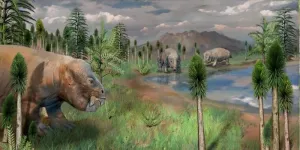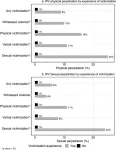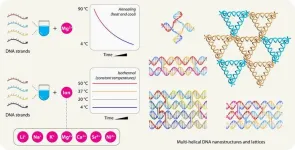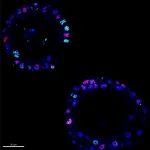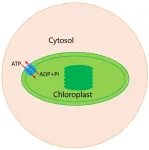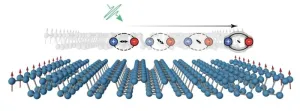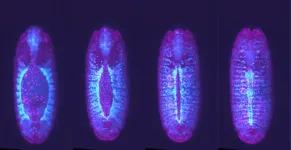China discovers terrestrial "Life oasis" from end-Permian mass extinction period
2025-03-12
A new study reveals that a region in China's Turpan-Hami Basin served as a refugium, or "Life oasis" for terrestrial plants during the end-Permian mass extinction, the most severe biological crisis since the Cambrian period.
The research, published in Science Advances, challenges the widely held view that terrestrial ecosystems suffered the same catastrophic losses as marine environments during this period.
The discovery, led by Prof. LIU Feng from the Nanjing Institute of Geology and Palaeontology (NIGPAS) of the Chinese Academy of Sciences, provides the first conclusive fossil evidence ...
Poor sleep may fuel conspiracy beliefs, according to new research
2025-03-12
A new study from the University of Nottingham has revealed that poor sleep quality may increase susceptibility to conspiracy beliefs, with depression likely playing a key role in this relationship.
Experts from the University’s School of Psychology examined the link between sleep quality and conspiracy beliefs in two studies involving over 1,000 participants. Their findings, published in the Journal of Health Psychology, indicate that individuals with poorer sleep quality over the past month were more likely to endorse conspiracy theories, particularly after exposure to conspiratorial content.
Conspiracy theories claim that powerful, secretive ...
Adolescent boys who experience violence have up to 8 times the odds of perpetrating physical and sexual intimate partner violence that same day, per South African study collecting real-time data over
2025-03-12
Adolescent boys who experience violence have up to 8 times the odds of perpetrating physical and sexual intimate partner violence that same day, per South African study collecting real-time data over mobile phones
Article URL: https://plos.io/4brsDzz
Article title: Measuring real-time violence exposure and its impact on intimate partner violence perpetration among adolescents
Author countries: US, South Africa
Funding: Research reported in this publication was supported by the National Institute of Mental Health under Award R01MH119878. The content is solely the responsibility of the authors ...
Critically endangered hawksbill turtles migrate up to 1,000km from nesting to foraging grounds in the Western Caribbean, riding with and against ocean currents to congregate in popular feeding hotspot
2025-03-12
Critically endangered hawksbill turtles migrate up to 1,000km from nesting to foraging grounds in the Western Caribbean, riding with and against ocean currents to congregate in popular feeding hotspots
Article URL: https://plos.io/41LfJZK
Article title: Inter-nesting area use, migratory routes, and foraging grounds for hawksbill turtles (Eretmochelys imbricata) in the Western Caribbean
Author countries: US, Honduras, Costa Rica
Funding: Funding for this project was provided by the Boyd Lyon Sea Turtle Fund to QDB, ...
UAlbany researchers unlock new capabilities in DNA nanostructure self-assembly
2025-03-12
ALBANY, N.Y. (March 12, 2025) — University at Albany researchers at the RNA Institute are pioneering new methods for designing and assembling DNA nanostructures, enhancing their potential for real-world applications in medicine, materials science and data storage.
Their latest findings demonstrate a novel ability to assemble these structures without the need for extreme heat and controlled cooling. They also demonstrate successful assembly in unconventional “buffer” substances including nickel. These developments, published today in the journal Science Advances, unlock new possibilities in DNA nanotechnology.
DNA ...
PM2.5 exposure may be associated with increased skin redness in Taiwanese adults, suggesting that air pollution may contribute to skin health issues
2025-03-12
PM2.5 exposure may be associated with increased skin redness in Taiwanese adults, suggesting that air pollution may contribute to skin health issues.
####
Article URL: https://plos.io/4iDTuuo
Article Title: Association between PM2.5 and skin redness features in Taiwan
Author Countries: Taiwan, United States
Funding: The authors received no specific funding for this work. END ...
BD² announces four new sites to join landmark bipolar disorder research and clinical care network
2025-03-12
Today, Breakthrough Discoveries for thriving with Bipolar Disorder (BD²) announced four new national institutions to receive $2.3 million each to join the BD² Integrated Network, a collaborative research and clinical care model that will improve care, interventions, and outcomes for people living with bipolar disorder.
University of Cincinnati/Lindner Center of HOPE, University of California San Diego, The University of Texas at Austin, and The Feinstein Institutes for Medical Research join the six inaugural institutions in the network. Working in partnership with clinicians, researchers, and people living ...
Digital Exclusion Increases Risk of Depression Among Older Adults Across 24 Countries
2025-03-12
Older adults who lack internet access are at a significantly higher risk of developing depressive symptoms, especially those with limited familial support or lower income levels, according to a new study published in Health Data Science. Conducted by an international team of researchers, this study analyzed data from five major aging cohort studies covering 24 countries, revealing a strong link between digital exclusion and mental health.
The researchers, led by Dr. Yinzi Jin from Peking University, investigated how digital exclusion—defined as the lack of internet access—affects the mental health of older adults. Using data from the Health and Retirement Study (HRS), ...
Quantum annealing processors achieve computational advantage in simulating problems on quantum entanglement
2025-03-12
Quantum annealing processors outperform classical supercomputers in solving real-world scientific simulations of quantum spin dynamics, researchers report in a new study, achieving results far beyond the capacity of conventional computational methods, which may require impossible time and energy to match. The results provide a challenge to classical computing, where method improvement has in the past tempered claims of quantum advantage. Only in recent years have quantum computers begun to live up to their lofty promises, with quantum processing units (QPUs) with diverse architectures – such as photonic, neutral-atom, and ...
How UV radiation triggers a cellular rescue mission
2025-03-12
How UV Radiation Triggers a Cellular Rescue Mission
Ultraviolet (UV) radiation from the sun is a well-known cause of DNA damage, which can lead to diseases like skin cancer. But how do our cells repair this damage to protect us? Researchers from Sabanci University, Veysel Oğulcan Kaya and Ogün Adebali, have uncovered a fascinating answer: when DNA is damaged by UV light, our cells reorganize their genetic material in 3D space to prioritize repair, in what might be called a “cellular rescue mission.”
A New Look at DNA Repair
DNA, the blueprint of ...
Hepatic stellate cells control liver function and regeneration
2025-03-12
Until now, doctors knew hepatic stellate cells mainly as drivers of liver fibrosis. The actual functions of this cell type have hardly been studied to date. Researchers from the German Cancer Research Center (DKFZ), the Mannheim Medical Faculty and Columbia University in New York have now published in the journal Nature that hepatic stellate cells control liver metabolism as well as liver regeneration and size. The results of the study could contribute to new therapeutic approaches for liver diseases.
The liver is a central organ for carbohydrate and protein metabolism as well as for the detoxification ...
The secret DNA circles fueling pancreatic cancer’s aggression
2025-03-12
Pancreatic cancer is one of the deadliest cancers worldwide, with a five-year survival rate of 13%. This poor prognosis stems from both late detection and the cancer’s notorious capacity to adapt and resist therapy. Now, a study led by researchers at the University of Verona, University of Glasgow, and the Botton-Champalimaud Pancreatic Cancer Centre uncovers a hidden driver of this adaptability: extrachromosomal DNA (ecDNA).
A New Player in Pancreatic Cancer
The team found that some pancreatic cancer cells gain a major survival edge by carrying copies of critical cancer genes—such as ...
2D metals: Chinese scientists achieve breakthrough in atomic manufacturing
2025-03-12
Since the groundbreaking discovery of graphene in 2004, the dizzying pace of progress in two-dimensional (2D) materials has ushered in a new era of fundamental research and technological innovation. Although nearly 2,000 2D materials have been theoretically predicted and hundreds have been created in laboratory settings, most of these 2D materials are limited to van der Waals (vdW) layered crystals.
Scientists have long been keen to develop atomically thin 2D metals, thereby expanding ...
Cause of post-COVID inflammatory shock in children identified
2025-03-12
MIS-C is a serious inflammatory shock that affects children. It can occur several weeks after a COVID infection and can be life-threatening. Until now, however, the precise cause of the condition was unknown. Researchers at Charité – Universitätsmedizin Berlin and the German Rheumatology Research Center (DRFZ), an institute of the Leibniz Association, have identified that reactivation of a pre-existing, dormant infection with the Epstein-Barr virus triggers an excessive inflammatory response. The researchers have detailed their findings in an article in Nature.* These insights open the door to new treatment methods, potentially not limited to MIS-C.
The majority of children ...
QIA researchers create first Operating System for Quantum Networks
2025-03-12
Delft, The Netherlands: Quantum Internet Alliance (QIA) researchers at TU Delft, QuTech, University of Innsbruck, INRIA and CNRS recently announced the creation of the first operating system designed for quantum networks: QNodeOS. The research, published in Nature, marks a major step forward in transforming quantum networking from a theoretical concept to a practical technology that could revolutionize the future of the internet.
“The goal of our research is to bring quantum network technology to all. With QNodeOS we're taking a big step forward. We're making it possible – ...
How the brain uses ‘building blocks’ to navigate social interactions
2025-03-12
Our brains use basic ‘building blocks’ of information to keep track of how people interact, enabling us to navigate complex social interactions, finds a new study led by University College London (UCL) researchers.
For the study, published in Nature, the researchers scanned the brains of participants who were playing a simple game involving a teammate and two opponents, to see how their brains were able to keep track of information about the group of players.
The scientists found that rather ...
Want to preserve biodiversity? Go big, U-M researchers say
2025-03-12
ANN ARBOR—Large, undisturbed forests are better for harboring biodiversity than fragmented landscapes, according to University of Michigan research.
Ecologists agree that habitat loss and the fragmentation of forests reduces biodiversity in the remaining fragments. But ecologists don't agree whether it's better to focus on preserving many smaller, fragmented tracts of land or larger, continuous landscapes. The study, published in Nature and led by U-M ecologist Thiago Gonçalves-Souza, comes to a conclusion on the decades-long debate.
"Fragmentation is bad," said study author Nate Sanders, U-M professor of ecology and evolutionary biology. ...
Ultra-broadband photonic chip boosts optical signals
2025-03-12
Modern communication networks rely on optical signals to transfer vast amounts of data. But just like a weak radio signal, these optical signals need to be amplified to travel long distances without losing information. The most common amplifiers, erbium-doped fiber amplifiers (EDFAs), have served this purpose for decades, enabling longer transmission distances without the need for frequent signal regeneration. However, they operate within a limited spectral bandwidth, restricting the expansion of optical networks.
To meet the growing demand for high-speed data transmission, researchers have been seeking ways to develop more powerful, flexible, ...
Chinese scientists explain energy transfer mechanism in chloroplasts and its evolution
2025-03-12
A recent study by Chinese scientists has revealed the intricate molecular machinery driving energy exchange within chloroplasts, shedding light on a key event in the evolution of plant life. Led by FAN Minrui from the Center for Excellence in Molecular Plant Sciences of the Chinese Academy of Sciences, the research elucidates the structure and function of the ATP/ADP translocator—a crucial member of the nucleotide transporter (NTT) family of proteins—which facilitates the transfer of energy across chloroplast membranes.
Their findings were published online in ...
Exciting moments on the edge
2025-03-12
Scientists have long suspected that phosphorene nanoribbons (PNRs) – thin pieces of black phosphorus, only a few nanometres wide – might exhibit unique magnetic and semiconducting properties, but proving this has been difficult. In a recent study published in Nature, researchers focused on exploring the potential for magnetic and semiconducting characteristics of these nanoribbons. Using techniques such as ultrafast magneto-optical spectroscopy and electron paramagnetic resonance they were able to demonstrate the magnetic behaviour of PNRs at room temperature, and show how these magnetic properties can interact with light.
The ...
MD Anderson Research Highlights for March 12, 2025
2025-03-12
HOUSTON ― The University of Texas MD Anderson Cancer Center’s Research Highlights showcases the latest breakthroughs in cancer care, research and prevention. These advances are made possible through seamless collaboration between MD Anderson’s world-leading clinicians and scientists, bringing discoveries from the lab to the clinic and back.
Study offers insights into evolutionary process driving pancreatic cancer
Read summary | Read study in Nature
Pancreatic cancer is hard to treat because ...
Lighting the way: how activated gold reveals drug movement in the body
2025-03-12
Gold nanoparticles (AuNPs) are tiny gold particles of 1–100 nanometers and have unique chemical and biological properties. Due to their potential to accumulate in tumors, these nanoparticles have emerged as promising drug carriers for cancer therapy and targeted drug delivery. However, tracking the movement of these nanoparticles in the body has been a major challenge. Traditional imaging methods often involve tracers like fluorescent dyes and radioisotopes, which give limited visualization and inaccurate results due to detachment from AuNPs.
In a step to advance the imaging of AuNPs, researchers from Waseda ...
SwRI-led PUNCH constellation launches
2025-03-12
SAN ANTONIO — March 12, 2025 — Four small suitcase-sized spacecraft, designed and built by Southwest Research Institute headquartered in San Antonio, launched from Vandenberg Space Force Base in California on March 11. NASA’s Polarimeter to Unify the Corona and Heliosphere, or PUNCH, constellation has spread out in a low-Earth orbit along the day-night line, providing a clear view in all directions for its two-year primary mission.
“The PUNCH spacecraft are now drifting into perfect position to study the solar corona, the Sun’s outer ...
Cells “speed date” to find their neighbors when forming tissues
2025-03-12
In developing hearts, cells shuffle around, bumping into each other to find their place, and the stakes are high: pairing with the wrong cell could mean the difference between a beating heart and one that falters. A study publishing on March 12 in the Cell Press journal Biophysical Journal demonstrates how heart cells go about this “matchmaking” process. The researchers model the intricate movements of these cells and predict how genetic variations could disrupt the heart development process in fruit flies.
In both humans and fruit flies, the heart’s tissues arise from two distinct regions of ...
Food insecurity today, heart disease tomorrow?
2025-03-12
Study compares those with food insecurity to food-secure individuals over 20 years
Food insecurity is associated with a 41% increased risk of heart disease over time
Findings suggest food security screening as a key tool to prevent heart disease
CHICAGO --- Struggling to afford food today could mean heart problems tomorrow. Young adults experiencing food insecurity have a 41% greater risk of developing heart disease in midlife, even after accounting for demographic and socioeconomic factors, according to a new Northwestern Medicine study. Food insecurity — struggling to get enough nutritious ...
[1] ... [492]
[493]
[494]
[495]
[496]
[497]
[498]
[499]
500
[501]
[502]
[503]
[504]
[505]
[506]
[507]
[508]
... [8690]
Press-News.org - Free Press Release Distribution service.
